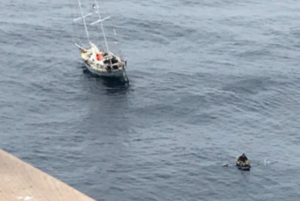Bus stop technology at play on Ainslie’s AC75

Ineos Team UK has revealed it’s using technology originally designed for bus stops. Papercast – e-paper information display systems – has delivered technology to supply data onboard, utilising its original knowledge from bus stops. The data delivery will be via displays which need to be highly readable in bright sunlight, robust and indifferent to temperature changes. The technical complexity of the boat means that a lot of information from the boat’s instrument system and hundreds of sensors needs to be instantly delivered to the crew.
“It’s impossible to sail these incredibly advanced and sophisticated boats without data, and getting that data in a fast, highly-readable format in the extreme environment of an AC75 cockpit is a real challenge,” says Sir Ben Ainslie.
“Papercast’s display technology has done a great job of delivering information everywhere that we needed it onboard, in the different forms that the crew specified. The guys have already given the displays a hammering in training and testing, and we’re also really pleased with the resilience. It’s been a great collaboration with Papercast,” says Nick Holroyd, Chief Designer of the Ineos Team.
And if you’ve been wondering how the team is managing to train and adhere to social distancing guidelines, it’s all down to a new strategy they’ve dubbed: Zero Covid days.
“The strategy covers everything from how we behave in our home lives through to how we operate in our base and in our community,” says Ainslie. “Hygiene is a big focus, for example, and we have given all team members Ineos hand sanitisers and Henri-Lloyd face coverings. Alongside that are our team’s social distancing policies which we can now monitor closely through social distancing devices we are using through a new partnership with a company called Mafic.
“These Mafic devices are wearables that can be attached to your arm or our Spinlock PFD (personal flotation device) that help us identify any hotspots where people are getting close to the two-metre social distancing barrier and ultimately help us make sure we are as safe as we can be in our working practices.
“The sailors use the same PPE and we have placed an e-grinder on the boat. That is effectively a large battery pack which reduces the requirement of the number of crew on the boat. That enables us to space out as much as possible whilst still being able to fully operate and sail the boat.”
 Henri-Lloyd (https://www.henrilloyd.com/p/buff-face-covering-2pk-and-filter) says its tube face coverings are made from a super soft fabric with 12% Lycra for stretch. The non-medical “Buff” style face coverings are reusable and machine washable at 40 degrees and come in a choice of two colours. Four non re-usable filters are included in a pack of two coverings. The filters are certified Standard 100 OEKO-Tex and are guaranteed not to release fibres that can be inhaled when worn.
Henri-Lloyd (https://www.henrilloyd.com/p/buff-face-covering-2pk-and-filter) says its tube face coverings are made from a super soft fabric with 12% Lycra for stretch. The non-medical “Buff” style face coverings are reusable and machine washable at 40 degrees and come in a choice of two colours. Four non re-usable filters are included in a pack of two coverings. The filters are certified Standard 100 OEKO-Tex and are guaranteed not to release fibres that can be inhaled when worn.
“As our challenge for the America’s Cup continues our focusses are now threefold. Firstly, we are making sure we keep the build of our America’s Cup race boat, Britannia II, on track. Carringtons, our boat builders in Hythe (Hampshire), have done a fantastic job and we are on track with that which is great news,” Ainslie continues.
“Secondly, we have to make sure we keep our first race boat, Britannia I, operational on the water in Portsmouth, which we have started doing again this week. There are a lot of development items that are coming through that will eventually get onto our second boat.
“Then, finally, it’s all about getting to New Zealand. That is proving to be something we can’t control, however we are doing absolutely everything we can to work with the New Zealand authorities to go through the correct processes. New Zealand have done an amazing job in terms of how they have responded to the crisis and hopefully we can find a workable process in order to enter the country.”











